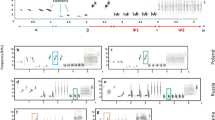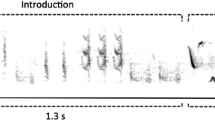Abstract
The syllable repertoire size of the great reed warbler (GRW) is known to underlay female preferences. However, its stability over a season—a key factor of this quality-related feature—has never been tested. Similarly, syllable repertoire composition, syllable sharing and its function in GRW have received little attention so far. GRW syllables fit into two categories: whistles and rattles. They differ in structure but nothing is known about their function. In the present study we analyze the above aspects of GRW vocalization. We found that syllable repertoire size and composition were stable within a season but significantly changed between years. Longitudinal analyses revealed that the changes in repertoire size were influenced more by the season than the age of individuals. The repertoire size correlated with harem size. Changes in repertoire size were significantly smaller than changes in composition, indicating varying seasonal usage of syllables present in the repertoires of individual birds. Syllable sharing was high and indifferent between neighbors and distant males. This pattern suggests that syllable sharing in GRW acts as a dialect. High levels of within- and between-season repertoire similarity among all recorded birds supported this view. Whistles were more shared and repeatable within and between seasons than rattles. We suppose that whistles may play an important role in determining a local dialect due to their lower changeability both between individuals and years. Within-season similarity of whistle repertoire to other males correlated with harem size, but similarity of rattle repertoire did not. This correlation may result from a female preference for philopatric males using the local dialect.








Similar content being viewed by others
References
Alatalo RV, Lundberg A, Ståhlbrandt K (1986) Female pied flycatchers choose territory quality and not male characteristics. Nature 323:152–153
Anderson M (1994) Sexual selection. Princeton University Press, Princeton
Ballentine B, Hyman J, Nowicki S (2004) Vocal performance influences female response to male bird song: an experimental test. Behav Ecol 15(1):163–168
Beecher MD, Brenowitz EA (2005) Functional aspects of song learning in songbirds. Trends Ecol Evol 20:143–149
Beecher MD, Campbell SE (2005) The role of unshared songs in singing interactions between neighbouring song sparrows. Anim Behav 70:1297–1304
Beecher MD, Stoddard PK, Campbell SE, Horning CL (1996) Repertoire matching between neighbouring song sparrows. Anim Behav 51:917–923
Beecher MD, Campbell SE, Burt JM, Hill CE, Nordby JC (2000a) Song-type matching between neighbouring song sparrows. Anim Behav 59:21–27
Beecher MD, Campbell SE, Nordby JC (2000b) Territory tenure in song sparrows is related to song sharing with neighbours, but not to repertoire size. Anim Behav 59:29–37
Bensch S, Hasselquist D (1992) Evidence for active female choice in a polygynous warbler. Animal Behavior 44:301–311
Bensch S, Hasselquist D, Nielsen B, Hansson B (1998) Higher fitness for philopatric than for immigrant males in a semi-isolated population of great reed warblers. Evolution 52:877–883
Brumm H, Dietmar T (2004) Male–male vocal interactions and the adjustment of song amplitude in a territorial bird. Anim Behav 67(2):281–286
Buchanan KL, Catchpole CK (1997) Female choice in the sedge warbler, Acrocephalus schoenobaenus: multiple cues from song and territory quality. Proc R Soc Lond B 264:521–526
Catchpole CK (1980) Sexual selection and the evolution of complex songs among European warblers of the genus Acrocephalus. Behaviour 74:149–166
Catchpole CK (1983) Variation in the song of the Great Reed Warbler Acrocephalus arundinaceus in relation to mate attraction and territorial defence. Anim Behav 31:1217–1225
Catchpole CK (1986) Song repertoires and reproductive success in the great reed warbler Acrocephalus arundinaceus. Behav Ecol Sociobiol 19:439–445
Catchpole CK (2000) Sexual selection and the evolution of song and brain structure in Acrocephalus warblers. Adv Study Behav 29:45–97
Catchpole CK, Slater PJB (1995) Bird song: biological themes and variations. Cambridge University Press, Cambridge
Catchpole CK, Leisler B, Dittami J (1986) Sexual differences in the responses of captive great reed warblers, Acrocephalus arundinaceus, to variation in song structure and repertoire size. Ethology 73:69–77
Collins S (2004) Vocal fighting and flirting: the functions of bird song. In: Marler P, Slabbekoorn H (eds) Nature’s music. Elsevier, San Diego, pp 39–79
Ezaki Y (1987) Male time budgets and recovery of singing rate after pairing in polygamous great reed warblers. Jpn J Ornithol 36:1–11
Fisher S, Frommolt K-H, Tembrock G (1996) Variability of song in the Great Reed Warbler Acrocephalus arundinaceus. J Ornithol 137:503–513
Forstmeier W, Leisler B (2004) Repertoire size, sexual selection, and offspring viability in the great reed warbler: changing patterns in space and time. Behav Ecol 15(4):555–563
Forstmeier W, Hasselquist D, Bensch S, Leisler B (2006) Does song reflect age and viability? A comparison between two populations of the great reed warbler Acrocephalus arundinaceus. Behav Ecol Sociobiol 59:634–643
Gil D, Cobbs JLS, Slater PJB (2001) Song characteristics are age dependent in the willow warbler (Phylloscopus trochilus). Anim Behav 62:689–694
Grießmann B, Naguib M (2002) Song sharing in neighbouring and non-neighbouring thrush nightingales and its implications for communication. Ethology 108:377–387
Hasselquist D (1994) Male attractiveness, mating tactics and realized fitness in the polygynous great reed warbler (Ph.D. thesis). University of Lund, Lund
Hasselquist D (1998) Polygyny in Great Reed Warblers: a long-term study of factors contributing to male fitness. Ecology 79(7):2376–2390
Hyman J (2002) Conditional strategies in territory defense: do Carolina wrens play tit-for-tat? Behav Ecol 13:664–669
Lampe HM, Sætre G-P (1995) Female pied flycatchers prefer males with larger song repertoires. Proc R Soc Lond B 262:163–167
Marchetti K, Price T (1989) Differences in the foraging of juvenile and adult birds: the importance of developmental constraints. Biol Rev Camb Philos Soc 64:51–70
McGregor PK, Krebs JR (1982) Mating and song types in the great tit. Nature 297:60–61
McGregor PK, Krebs JR (1989) Song learning in adult great tits (Parus major): effects of neighbours. Behaviour 108:139–159
Mountjoy DJ, Lemon RE (1996) Female choice for complex song in the European starling: a field experiment. Behav Ecol Sociobiol 38:65–71
Nicholson J, Buchanan KL, Marshall RC, Catchpole CK (2007) Song sharing and repertoire size in the sedge warbler Acrocephalus schoenobaenus: changes within and between years. Anim Behav 74:1585–1592
Nowicki S, Peters S, Podos J (1998) Song learning, early nutrition and sexual selection in songbirds. Am Zool 38:179–190
Nowicki S, Hasselquist D, Bensch S, Peters S (2000) Nestling growth and song repertoire size in great reed warblers: evidence for song learning as an indicator mechanism in mate choice. Proc R Soc Lond B 267:2419–2424
Reid JM, Arcese P, Cassidy ALEV, Hieberts SM, Smith JNM, Stoddard PK, Keller LF, Marr AB (2004) Song repertoire size predicts initial mating success in male song sparrows Melospiza melodia. Anim Behav 68:1055–1063
Searcy WA (1992) Song repertoire and mate choice in birds. Am Zool 32:71–80
Smith JNM (1988) Determinants of lifetime reproductive success in the song sparrow. In: Clutton-Brock TH (ed) Reproductive success: studies of individual variation in contrasting breeding systems. University of Chicago Press, Chicago, pp 154–172
Trivers RL (1972) Parental investment and sexual selection. In: Campbell B (ed) Sexual selection and the descent of man. Heinemann, London, pp 137–179
Vallet E, Beme I, Kreutzer M (1998) Two-note syllables in canary songs elicit high levels of sexual display. Anim Behav 55:291–297
Vehrencamp SL (2000) Handicap, index, and conventional signal elements of bird song. In: Espmark Y, Amundsen T, Rosenqvist G (eds) Animal signals: signalling and signal design in animal communication. Tapir, Trondheim, pp 277–300
Węgrzyn E (2006) Individual differences and their function in the song of the Great Reed Warbler Acrocephalus arundinaceus (Ph.D. thesis). University of Wrocław, Wrocław
Wilson PL, Towner MC, Vehrencamp SL (2000) Survival and song-type sharing in a sedentary subspecies of the song sparrow. Condor 102:355–363
Acknowledgments
Ewa Węgrzyn was supported by the POL-POSTDOC III grant no. PBZ MNiSW 07/2006/13.
The authors thank Prof. Tomasz S. Osiejuk for helpful comments and suggestions about the manuscript.
Author information
Authors and Affiliations
Corresponding author
Additional information
Communicated by F. Bairlein.
Rights and permissions
About this article
Cite this article
Węgrzyn, E., Leniowski, K. Syllable sharing and changes in syllable repertoire size and composition within and between years in the great reed warbler, Acrocephalus arundinaceus . J Ornithol 151, 255–267 (2010). https://doi.org/10.1007/s10336-009-0451-x
Received:
Revised:
Accepted:
Published:
Issue Date:
DOI: https://doi.org/10.1007/s10336-009-0451-x




